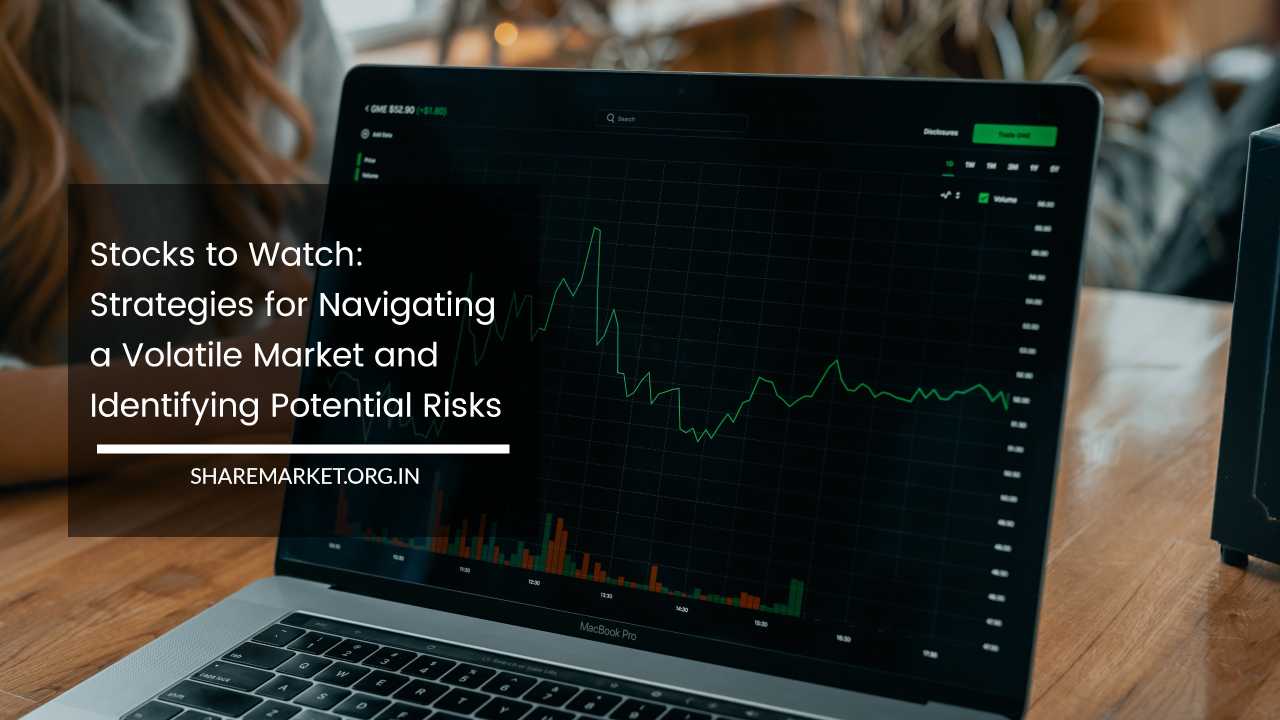Stocks to Watch: Strategies for Navigating a Volatile Market and Identifying Potential Risks

Stocks to Watch
Navigating Volatile Markets: Expert Advice on Stock Selection
In today’s financial landscape, navigating the stock market can often resemble a rollercoaster ride, characterized by sharp ups and downs.
Retail investors, in particular, are frequently left wondering where to place their bets and, equally importantly, where to steer clear.
To shed light on these crucial questions, we turn to Nishit Master, a Portfolio Manager at Axis Securities PMS, whose insights can help investors make informed decisions in these turbulent times.
The Current Market Scenario
The recent weeks have witnessed a tumultuous period in the Indian stock market. A sharp decline was recorded, leaving investors on edge.
However, there appears to be a glimmer of hope, with some relief seen in the benchmark Nifty and Sensex, and the return of the bulls to Dalal Street.
But is this the start of a new bullish phase? Market experts are cautious and suggest that the recent rally should be perceived as a pullback rather than a full-fledged boom.
This surge can be better understood as a temporary rally of relief, primarily driven by dovish comments from US Federal Reserve Chairman Jerome Powell.
The next pivotal factors to watch are the release of US non-agricultural payroll and retail inflation data, which are anticipated to significantly influence the direction of the market. With these figures in play, the Indian equity market may experience heightened volatility.
Correction for Market Health
Nishit Master believes that the recent correction in the Indian markets, which followed a period of high returns, is expected to have a positive impact on the overall health of the market.
This correction is likely to lead to improved valuations, especially for small and medium-cap stocks.
Analyzing the market segments, it’s noteworthy that the large-cap index has more or less returned to its long-term average, whereas the small and mid-cap index is currently trading above its long-term average.
However, the growth in the latter segment has decelerated. This correction has not only reduced inflation within small and mid-cap indices but has also contributed to their improved health.
Sectoral Insights
Nishit suggests that investors focus their attention on sectors where earnings are expected to see an increase. Specifically, sectors such as capital goods, healthcare, auto, and hospitality appear promising at the moment.
These sectors are characterized by potential growth opportunities and are well-positioned to weather market turbulence.
Conversely, Nishit advises staying away from the IT and metal sectors. Both these sectors currently face challenges, primarily a decline in demand.
The IT industry may potentially suffer from the repercussions of economic recessions in Europe and the US. On the other hand, the metal sector could see a negative impact due to the slowdown in the Chinese economy, which is expected to affect both demand and prices.
Building Your Portfolio for Resilience
In this uncertain market environment, Nishit’s advice to retail investors is to anchor their portfolios in quality stocks with robust cash flow potential.
In volatile markets, it’s crucial to identify stocks with a strong track record of cash flow generation. Equally important is ensuring that these stocks are currently priced at favorable valuations and possess considerable growth potential for the future.
To minimize risks in the volatile market, diversification is key. Nishit recommends allocating approximately 40-60 percent of your portfolio to large-cap stocks, providing stability and consistency. At the same time, keep 20-30 percent of your portfolio in mid-cap stocks, which offer a balanced mix of growth potential and stability.
The remaining 20-30 percent should be allocated to small-cap stocks, which can provide high growth opportunities.
When considering investments in small and mid-cap stocks, Nishit emphasizes the importance of focusing exclusively on quality stocks with a strong track record. This approach helps mitigate risks associated with these segments.
Market Uncertainty and the Importance of Cash Flow
In the world of investing, uncertainty is a constant companion, but in volatile markets, it becomes even more pronounced.
This uncertainty can be both an opportunity and a risk, depending on how investors approach it. One of the crucial metrics that Nishit Master highlights in these turbulent times is cash flow.
Cash flow is the lifeblood of a business. It represents the money coming in and going out of a company and is essential for its sustainability and growth.
For investors, understanding a company’s cash flow can provide insights into its financial health and its ability to weather economic storms.
In a market known for its swings and unpredictability, having stocks with solid cash flow potential in your portfolio can provide a level of stability and confidence.
Companies with a history of generating positive cash flows are often better equipped to endure economic downturns, making them attractive options for investors during volatile times.
Moreover, assessing cash flow can also help investors identify mispriced stocks. When a company’s stock is trading at a discount to its intrinsic value and it has a strong cash flow history, it may present a compelling investment opportunity.
In contrast, stocks that are trading at high valuations without the underlying support of robust cash flows may be overvalued and vulnerable to corrections.
The Value of Valuations
Valuations play a critical role in investment decisions. Understanding the price you are paying for a stock in relation to its intrinsic value is fundamental to sound investing. While it’s often tempting to chase stocks with soaring prices, this approach can be risky in volatile markets.
Investors must exercise caution and discipline when it comes to valuations. Nishit’s recommendation to invest in stocks that are currently priced at good valuations aligns with the core principle of value investing. Value investors seek stocks that are trading below their intrinsic value, offering a margin of safety.
In volatile markets, where sudden price swings are common, investing in stocks with attractive valuations can provide a safety net.
Even if the market experiences a correction, these stocks may have less downside risk because they were purchased at a discount. It’s a strategy that focuses on long-term gains and minimizes short-term losses.
Quality over Quantity
One of the common mistakes investors make, especially during market turbulence, is chasing quantity over quality. It’s easy to become lured by the promise of quick profits or the temptation to speculate on high-risk, high-reward investments. However, Nishit’s guidance emphasizes the importance of quality stocks.
Quality stocks are typically associated with established companies that have a proven track record of performance.
They often have strong fundamentals, a history of profitability, and the ability to generate consistent cash flows. Investing in quality stocks can provide a sense of stability and resilience in a volatile market.
Quality should not be sacrificed for quantity. While it’s tempting to diversify a portfolio with numerous stocks, it’s equally important to ensure that each stock meets certain quality criteria. Even with a smaller number of quality stocks, you can build a robust and well-performing portfolio.
The Role of Diversification
Diversification is a risk management strategy that involves spreading investments across different assets to reduce exposure to any single asset or risk.
In the context of stock market investing, diversification can be applied by investing in stocks from various sectors and market segments.
Nishit’s recommendation to allocate a substantial portion of your portfolio to large-cap stocks provides a stable foundation.
Large-cap stocks are generally associated with well-established, financially sound companies. They often have diversified revenue streams and a global presence, which can help them withstand market volatility.
Mid-cap stocks, which constitute a significant part of the recommended allocation, offer a balance between growth potential and stability.
These companies are often in a growth phase, which can result in above-average returns. However, they are not as volatile as small-cap stocks, making them a valuable addition to a diversified portfolio.
Small-cap stocks can provide opportunities for high growth, but they also come with higher risk. Therefore, dedicating a portion of your portfolio to this segment should be done selectively, focusing on quality stocks with a strong track record.
Diversification spreads risk across different market segments and can help cushion the impact of adverse movements in any one sector. It’s a strategy that balances the pursuit of returns with the management of risks.
The Importance of Staying Informed
In the fast-paced world of finance, staying informed is crucial. Nishit Master’s insights, shared through in an interview, highlight the significance of keeping a watchful eye on the market’s ebbs and flows.
Monitoring economic indicators, corporate developments, and global events can provide a deeper understanding of the market’s current state and potential future trends. It’s essential for investors to be proactive in gathering information and making informed decisions.
Staying informed doesn’t mean reacting impulsively to every news headline. Instead, it involves thoughtful analysis and a strategic approach.
Investors should seek reliable sources of information, consider multiple viewpoints, and consult with financial advisors when necessary.
Final Words
In today’s volatile market, Nishit Master’s advice offers a valuable compass for investors seeking to make well-informed decisions.
While the market may remain unpredictable, investors can navigate these uncertainties by focusing on quality stocks with strong cash flow potential, favorable valuations, and robust growth prospects.
It’s essential to approach investment decisions with discipline and a long-term perspective. By diversifying their portfolios and carefully selecting stocks from sectors with growth potential, investors can position themselves to weather the storms and seize opportunities as they arise.
Market corrections and turbulence are not necessarily a cause for alarm but an opportunity to reassess and refine one’s investment strategy.
Remember that quality, in both stocks and information, is key. By incorporating these principles into your investment approach, you can build a resilient portfolio that stands the test of time, no matter how turbulent the market may be.

















